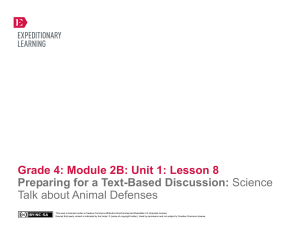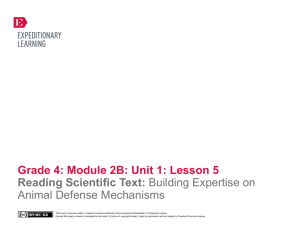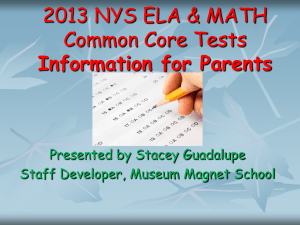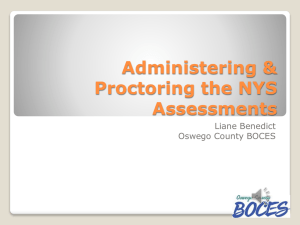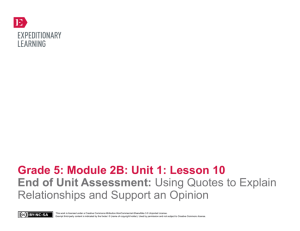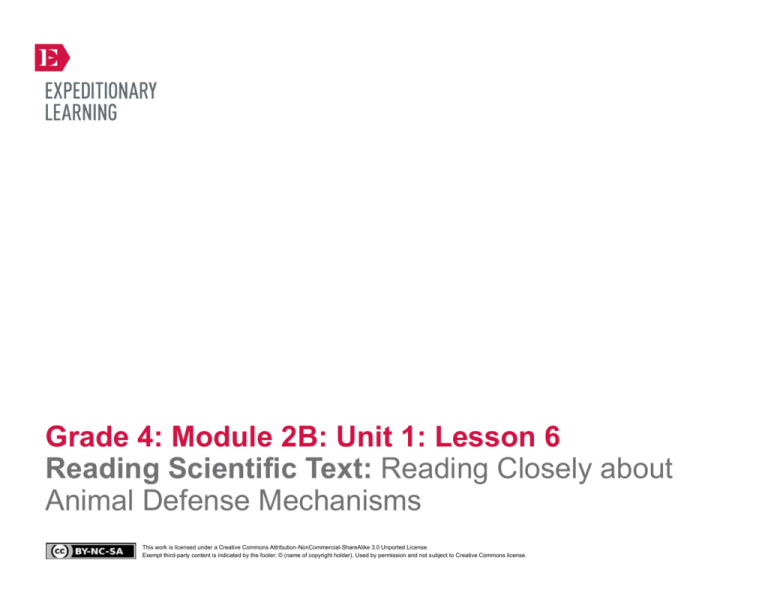
Grade 4: Module 2B: Unit 1: Lesson 6
Reading Scientific Text: Reading Closely about
Animal Defense Mechanisms
This work is licensed under a Creative Commons Attribution-NonCommercial-ShareAlike 3.0 Unported License.
Exempt third-party content is indicated by the footer: © (name of copyright holder). Used by permission and not subject to Creative Commons license.
GRADE 4: MODULE 2B: UNIT 1: LESSON 6
Reading Scientific Text:
Reading Closely about Animal Defense Mechanisms
Long-Term Targets Addressed (Based on NYSP12 ELA CCLS)
I can determine the main idea using specific details from the text. (RI.4.2)
I can paraphrase portions of a text that are read aloud to me. (SL.4.2)
I can document what I learn about a topic by taking notes. (W.4.8)
Supporting Learning Targets
Ongoing Assessment
• I can identify details that support the main idea of a section of Animal Behaviors: Animal Defenses.
• Determining the Main Idea note-catcher (pages 9 and 10
in Animal Defenses research journal)
• I can paraphrase and take notes on information presented by my peers in Jigsaw groups.
• Observation of participation during Jigsaw
Copyright © 2013 by Expeditionary Learning, New York, NY. All Rights Reserved.
NYS Common Core ELA Curriculum • G4:M2B:U1:L6 • June 2014 •
1
GRADE 4: MODULE 2B: UNIT 1: LESSON 6
Reading Scientific Text:
Reading Closely about Animal Defense Mechanisms
Agenda
Teaching Notes
Opening
• This is the second lesson where students read sections from Animal Behavior: Animal Defenses. In the
previous lesson, students worked in expert groups to examine a visual in their section of the anchor text
and determine the main idea of that section. In this lesson, they will continue working in the same
groups to identify details that support the main idea.
A. Engaging the Reader: Quiz-Quiz-Trade (15 minutes)
B. Reviewing Learning Targets (5 minutes)
Work Time
A. Rereading an Informational Text: Identifying
Supporting Details (25 minutes)
Closing and Assessment
A. Jigsaw Share and Debrief (15 minutes)
Homework
A. Animal Behavior: Animal Defenses Vocabulary
• Students will then regroup into Jigsaw triads, with one representative from each expert group in each
Jigsaw triad. In triads, they will share the main idea of their section while their partners listen,
paraphrase, and take notes on their Determining the Main Idea note-catchers. This provides additional
practice in the long-term target “I can paraphrase portions of a text that is read aloud to me” (SL.4.2) as
well as the long-term target “I can document what I learn about a topic by taking notes” (W.4.8).
• You may determine the triad groups in advance and strategically group students. One possible
arrangement to consider would be to group ELLs who speak the same home language in the same
group, allowing them to have more meaningful discussions and clarify points in their native language.
• In advance: Determine triad groups.
• Review: Jigsaw protocol, Quiz-Quiz-Trade, and Fist to Five in Checking for Understanding techniques
(see Appendix).
• Post: Learning targets.
Copyright © 2013 by Expeditionary Learning, New York, NY. All Rights Reserved.
NYS Common Core ELA Curriculum • G4:M2B:U1:L6 • June 2014 •
2
GRADE 4: MODULE 2B: UNIT 1: LESSON 6
Reading Scientific Text:
Reading Closely about Animal Defense Mechanisms
Lesson Vocabulary
Materials
support, alert (7), camouflage (21),
self-defense, escape (22), chemical
defense (55), irritate, substances (76),
paralyze, mimic (91), imitating
• Vocabulary word cards (for teacher use; see Teaching Notes)
• Animal Behavior: Animal Defenses (book; one per student and one to display)
– Teacher model—“Avoiding Danger” (pages 7–9, stopping at “Self-Defense”; last two paragraphs on page 21; “Escape
Artists” first two paragraphs on page 22)
– Group 1—“Bad Smells, Bad Tastes, and Powerful Poisons” (page 55–top of 56, stopping at “Poisonous Prey”; pages 58–
60)
– Group 2—“Venomous Stings and Bites” (page 73; “How Venom Works” box on page 76; “Stinging Tentacles” pages 77–78)
– Group 3—“Mimicry” (pages 91–94)
• Animal Defenses Research Journal (from Lesson 1)
• Determining the Main Idea note-catcher (pages 9 and 10 of Animal Defenses research journal; one per student and one to
display)
• Determining the Main Idea note-catcher (completed, for teacher reference)
Copyright © 2013 by Expeditionary Learning, New York, NY. All Rights Reserved.
NYS Common Core ELA Curriculum • G4:M2B:U1:L6 • June 2014 •
3
GRADE 4: MODULE 2B: UNIT 1: LESSON 6
Reading Scientific Text:
Reading Closely about Animal Defense Mechanisms
Meeting Students’ Needs
Opening
A. Engaging the Reader: Quiz-Quiz-Trade (15 minutes)
• Explain to students that you would like them to do a short activity called Quiz-Quiz-Trade using words from the Word Wall
to help build their understanding of these words. Post the following directions for students: Quiz-Quiz-Trade:
1. Find a partner.
2. Read definition—Read your word’s definition to your partner. Allow him or her to guess the word or ask for a hint.
3. Give a hint—If your partner needs a hint, say one thing that helps you remember the meaning of this word. Allow your
partner to guess and share your word.
4. Switch—Have your partner read his or her definition and let you guess or receive a hint.
5. Trade cards, and find a new partner. Repeat Steps 2 through 5.
• Review the directions and clarify or model process if necessary. Distribute Vocabulary word cards. Point out to students
that the word is on one side of the card and the definition is on the other, and that there are several new words added from
today’s reading. Tell them to be sure to cover the word so their partner cannot see it when trying to guess the word.
• Give students 8 minutes to quiz and trade. Collect the word cards.
B. Reviewing Learning Targets (5 minutes)
• Discussing and clarifying the
language of learning targets helps
build academic vocabulary.
• Invite students to read the learning targets:
– “I can identify details that support the main idea of a section of Animal Behaviors: Animal Defenses.”
– “I can paraphrase and take notes on information presented by my peers in Jigsaw groups.”
• Underline the phrase main idea. Ask students to turn and talk with a partner, discussing:
* “What is the main idea of a text?” Listen for responses like: “It’s the most important idea from the text.”
• Circle the word support and ask them to share with their partner what they think the word determine means. Listen for
responses like: “It means to give evidence for or verify.” Tell students that they will find details that support, or verify, the
main idea of their section of the text.
Copyright © 2013 by Expeditionary Learning, New York, NY. All Rights Reserved.
NYS Common Core ELA Curriculum • G4:M2B:U1:L6 • June 2014 •
4
GRADE 4: MODULE 2B: UNIT 1: LESSON 6
Reading Scientific Text:
Reading Closely about Animal Defense Mechanisms
Work Time
Meeting Students’ Needs
A. Rereading an Informational Text: Identifying Supporting Details (25 minutes)
• Consider offering selected shorter
passages to specific groups based on
the readiness and needs of the
group. This provides an opportunity
for students to read a complex text
within the fourth-grade level span,
but differentiates the length of the
text, not the complexity.
• Remind students that they have been working with a section of Animal Behavior: Animal Defenses to determine the
main idea.
• Explain that they will now have a chance to reread their section of the text with their expert groups to find details that
support the main idea of their section.
• Invite students to gather into their expert groups and turn and talk about the following question:
* “What is the main idea of your expert group’s section of Animal Behavior: Animal Defenses?”
• Tell students to open to pages 9 and 10 of their Animal Defenses Research Journal to the Determining the Main
Idea note-catcher. Ask:
* “How do we identify details that support the main idea of a section of the text?”
• Listen for students describing the process discussed in Lesson 4, saying something like: “We reread the text paragraph by
paragraph, thinking about the main idea and looking for facts or details that the author used to explain that idea.” Tell
students they should write the supporting details for their section only. Explain that they should leave the other sections
blank for now.
• Review identifying details that support the main idea of “Avoiding Danger” (pages 7–9, the last two paragraphs on page 21,
and the first two paragraphs on page 22) and going through the steps just discussed. Have students turn and talk after each
step before discussing the step with the whole group. Model recording the supporting details in the appropriate box on the
Determining the Main Idea note-catcher and ask students to do the same.
• Give students 15 minutes to work through the steps with their partners to identify details that support the main idea of their
section. Circulate and support as needed. Listen for students using the steps and following class norms when working in a
small group. Probe by asking: “How does that detail support the main idea?” or “Why does this detail better support the
main idea than that detail?” Be sure to check in with students who gave a thumbs-down at the end of Work Time Part B in
Lesson 5 and who expressed that they did not feel confident in meeting the target discussed in the Closing and Assessment
of Lesson 4.
• After 15 minutes, invite students to show a thumbs-up if they were able to identify details that support the main idea of their
section and a thumbs-down if they were not. Praise students showing a thumbs-up. Check in with students who gave a
thumbs-down during the closing of the lesson.
Copyright © 2013 by Expeditionary Learning, New York, NY. All Rights Reserved.
• Graphic organizers and recording
forms engage students more actively
and provide the necessary
scaffolding that is especially critical
for learners with lower levels of
language proficiency and/or
learning. For students needing
additional support, provide a
partially filled-in graphic organizer.
• Provide ELLs with a sentence
starter or frame to aid in language
production. For example: One idea
that is repeated again and again
is … or A detail that supports the
main idea of our section is …
• Some students may benefit from
having key sections pre-highlighted
in their texts. This will help them
focus on small sections.
NYS Common Core ELA Curriculum • G4:M2B:U1:L6 • June 2014 •
5
GRADE 4: MODULE 2B: UNIT 1: LESSON 6
Reading Scientific Text:
Reading Closely about Animal Defense Mechanisms
Meeting Students’ Needs
Closing and Assessment
A. Jigsaw Share and Debrief (15 minutes)
• Explain to students that they will now regroup into triads, with one person from each expert Jigsaw group in each triad. Tell
students they will be sharing the main idea of their section as well as the details their group identified as best supporting the
main idea.
• Invite students to use the following steps to share:
1. Group 1 representative starts. Group 2 and 3 representatives listen.
2. Group 1 representative tells partners the main idea of his or her section. Group 2 and 3 representatives paraphrase the
main idea.
3. Group 2 and 3 representatives write the main idea of that section in the appropriate spot on their Determining the Main
Idea note-catchers.
4. Group 1 representative shares supporting details. Group 2 and 3 representatives paraphrase the supporting details.
5. Group 2 and 3 representatives write the supporting details for that section in the appropriate spot on their note-catchers.
6. Repeat the process for Group 2 representative’s share and Group 3 representative’s share.
• Circulate and support as needed. Use this as an opportunity for formative assessment for the targets “I can paraphrase
portions of a text that is read aloud to me,” (SL.4.2) and “I can document what I learn about a topic by taking notes” (W.4.8).
• Debrief using the Jigsaw protocol.
• Use the Fist to Five Checking for Understanding technique to ask students to rate their participation in the Jigsaw. Tell
students to show a fist if they did not participate, did not add to their group’s conversation, or did not follow class norms.
Tell students to show a five if they consistently participated, added to their group’s conversation, stayed on task, and
followed class norms.
• Inform students that they will continue working with this article in the next lesson.
Meeting Students’ Needs
Homework
• Reread your section of Animal Behavior: Animal Defenses read in today’s lesson. While you read, write down words that
you do not know the meaning of. Choose one word you circled and try to figure out the definition of it. Write down how you
figured out what the word meant as well.
Copyright © 2013 by Expeditionary Learning, New York, NY. All Rights Reserved.
NYS Common Core ELA Curriculum • G4:M2B:U1:L6 • June 2014 •
6
Grade 4: Module 2B: Unit 1: Lesson 6
Supporting Materials
This work is licensed under a Creative Commons Attribution-NonCommercial-ShareAlike 3.0 Unported License.
Exempt third-party content is indicated by the footer: © (name of copyright holder). Used by permission and not subject to Creative Commons license.
GRADE 4: MODULE 2B: UNIT 1: LESSON 6
Vocabulary Word Cards (Front):
Animal Defense Words
Teacher Directions: Type in six words and definitions that your class has recorded on the Word
Wall or in the vocabulary section of the Animal Defenses research journal into the following template
and make enough copies so that each student will have a card (most likely two or more sets).
Copyright © 2013 by Expeditionary Learning, New York, NY. All Rights Reserved.
NYS Common Core ELA Curriculum • G4:M2B:U1:L6 • June 2014 •
8
GRADE 4: MODULE 2B: UNIT 1: LESSON 6
Vocabulary Word Cards (Back):
Animal Defense Words Definitions
Teacher Directions: Type in six words and definitions that your class has recorded on the Word
Wall or in the vocabulary section of the Animal Defenses research journal into the following template
and make enough copies so that each student will have a card (most likely two or more sets).
Copyright © 2013 by Expeditionary Learning, New York, NY. All Rights Reserved.
NYS Common Core ELA Curriculum • G4:M2B:U1:L6 • June 2014 •
9
GRADE 4: MODULE 2B: UNIT 1: LESSON 6
Animal Defenses Research Journal:
Determining Main Ideas
(Completed, for Teacher Reference)
Source: Animal Behavior: Animal Defenses
Reread the text and identify the main idea for each section of the text.
“Avoiding Danger” (pages 7–9, stopping at “Self-Defense”; last two paragraphs on page
21; and “Escape Artists” first two paragraphs on page 22)
Main Idea:
Animals use many behaviors
to defend themselves from
predators.
Supporting Details:
“The black bands that run down the gazelles’ sides quiver, passing
along the message: ‘Danger!’” (page 7)
“being alert is the first step an animal takes to defend itself.” (page 9)
“Most animals are born ‘knowing’ how to defend themselves.” (page
9)
“Hiding, camouflage, and masking help animals avoid predators.”
(page 21)
“For many animals, this defense is escape.” (page 22)
“Bad Smells, Bad Tastes, and Powerful Poisons” (pages 55–56, stopping at “Poisonous
Prey”; pages 58–60)
Main Idea:
Many animals that protect
themselves with chemical
defenses are brightly colored
to warn predators to stay
away.
Supporting Details:
“these chemicals may have a bad taste, a terrible smell, or both. They
may irritate the skin as well as the senses. They also may be
poisonous.” (page 55)
“bright colors can also be warning colors … the colors say to
predators, ‘Don’t even think of attacking me. You’ll be sorry.’” (page
58)
“the predator learns that it is a bad idea to attack this sort of prey. It is
unlikely to go after another animal that looks like this disastrous
meal.” (page 58)
“ladybugs with bright red shells and black dots are also wearing
warning colors. The bright pattern signals that the ladybug may
sicken or kill a small animal that eats it.” (page 59)
“Moths, butterflies, and caterpillars that are poor-tasting or
poisonous have warning colors as well.” (page 60)
Copyright © 2013 by Expeditionary Learning, New York, NY. All Rights Reserved.
NYS Common Core ELA Curriculum • G4:M2B:U1:L6 • June 2014 •
10
GRADE 4: MODULE 2B: UNIT 1: LESSON 6
Animal Defenses Research Journal:
Determining Main Ideas
(Completed, for Teacher Reference)
Source: Animal Behavior: Animal Defenses
Reread the text and identify the main idea for each section of the text.
“Venomous Stings and Bites” (page 73; “How Venom Works” box on page 76; “Stinging
Tentacles” pages 77–78)
Main Idea:
Some animals protect
themselves by injecting
venom into their enemy.
Supporting Details:
“a venomous animal has a sting, spines, or specialized teeth attached
to venom-making glands” (page 73)
“some venomous animals use venom to catch their own prey” (page
73)
“many venomous animals … are camouflaged. This helps them sneak
up on prey.” (page 73)
“the body of a venomous animal uses energy to make venom … even
an animal that makes venom only for self-defense is usually slow to
use it. It is more likely to hide, flee, or warn a predator to stay away.”
(page 76)
“when an animal—either predator or prey—comes in contact with a
tentacle with venomous nematocysts, the nematocysts launch their
harpoons.” (page 77)
“Mimicry” (pages 91–94)
Main Idea:
Some animals protect
themselves by mimicking
other animals.
Supporting Details:
“mimicry includes sounding, smelling, acting, or otherwise
resembling another animal” (page 91)
“an insect that looks and acts like a bee … is not hiding. It is imitating
a living thing that a predator could eat. At the same time, it warns the
predator not to attack.” (page 91–92)
“animals mimic their prey in order to hunt them” (page 93)
“venomous animals mimic less harmful animals” (page 92)
“other animals mimic to live inside other animals’ nests” (page 92)
Copyright © 2013 by Expeditionary Learning, New York, NY. All Rights Reserved.
NYS Common Core ELA Curriculum • G4:M2B:U1:L6 • June 2014 •
11

